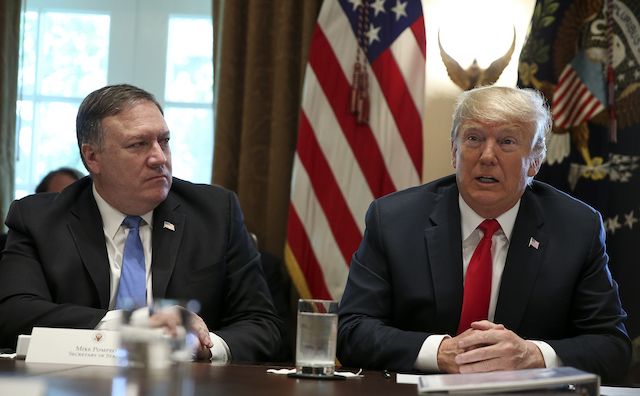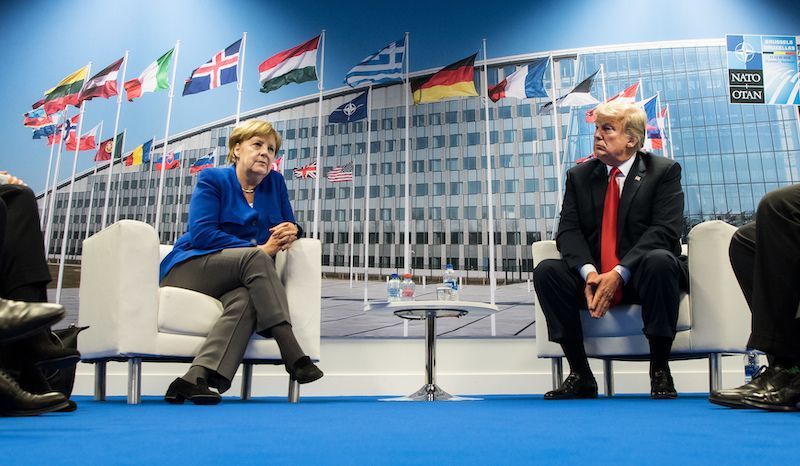2019 Outlook: U.S. foreign policy to stay the course
President Donald Trump succeeded in 2018 in getting U.S. allies and competitors to pay serious attention to his foreign policy agenda. His administration is undaunted in pursuing policy goals despite replacements of key security officials.

In a nutshell
- In 2018, Washington’s initiatives largely achieved the outcomes President Trump was looking for
- The U.S. goals in Asia, the Middle East and Europe are not likely to change in 2019
- The U.S. leader has to contend with some significant wild cards, including dealing with the U.S. Congress
In 2017, the administration released the United States National Security Strategy of the freshly-elected President Donald Trump. The big news of 2018 is that the White House mostly followed the blueprint laid out by the administration in the previous year, despite replacing key top members of his national security team. Furthermore, Washington’s initiatives largely achieved the outcomes President Trump was looking for despite fierce domestic opposition and widespread criticism abroad from friends and allies. The results of the mid-term election in 2018 will have little long-term impact on U.S. foreign policy. Expect the White House to follow the same playbook in 2019. It will be an activist year in foreign affairs before Mr. Trump turns his attention toward a reelection bid in 2020.
Showman and president
Events in 2018 consistently showed that one should not interpret U.S. policies solely on the basis of the president’s tweets and off-the-cuff comments. “Showman president” is the concept many employ as they try to assess the country’s direction. This has led many to see the Trump administration’s policies as ill-disciplined, chaotic, impulsive and even irrational. Mr. Trump, however, tweets for many reasons – often having little to do with articulating U.S. policies. Cherry-picking his tweets and comments as a means for ascertaining U.S. plans in the international arena is a fool’s errand.
There is a serious President Trump, the behind-the-scenes decision maker. Although in some respects he may be an unconventional statesman, he is following through on a coherent agenda. This agenda is focused on crushing transnational terrorist threats to the U.S. and its allies, and dealing with great power competition, particularly in three critical strategic regions: Europe, the Middle East and Asia.
Here is how these priorities unfolded in 2018.
China and Southeast Asia
The administration’s strategy signaled that the U.S. would address the destabilizing rise of China by challenging Beijing economically, diplomatically and militarily in the areas where the Communist government impinged on vital U.S. interests. Washington rolled out a punishing array of tariffs intended not so much as a protectionist policy but as a stiff price tag for China’s intolerable practices, particularly regarding intellectual property theft, unfair trade practices and blocking U.S. companies from competing in Chinese markets.
The most visible aspect of those initiatives was the growing strategic partnership with India.
Whether one agrees with this strategy or not, the White House shows no sign of abandoning it. On the diplomatic front, the administration has embraced the Quad (a four-power dialogue with Australia, India, and Japan) and the concept of a “free and open Indo-Pacific.” The most visible aspect of those initiatives in 2018 was the growing strategic partnership with India. Militarily, the U.S. has conducted freedom of navigation operations in the South China Sea and reaffirmed support for Taiwan. Both measures are specifically intended to show that the U.S. is not in retreat from military commitments in the region. Also, in Afghanistan, the U.S. support mission will continue in some form.
The Middle East
The White House strategy singled out Iran as the primary threat to stability in the region. As anticipated, the White House concluded that the nuclear deal with Iran had proved insufficient for deterring an Iranian nuclear breakout or restraining Iran’s support for the Assad regime, Hezbollah Hamas and Iraqi Shia militias, and the Houthis in Yemen – all of which the administration identifies as threats to regional security.
As a result, the U.S. has withdrawn from the Joint Comprehensive Program of Agreement (JCPOA) with Iran and ramped up its efforts to contain the actors of instability. The administration launched aggressive (and largely successful) sanctions against Iran. It has continued, albeit in a changed form, to support anti-ISIS efforts in Syria and maintained U.S. engagement in Iraq. It has kept pressure on the Palestinians and reengaged with Egypt. It supports the Saudis’ and United Arab Emirates’ operations in Yemen with arms sales – all to block Iran’s influence.
Washington has had setbacks on the diplomatic front. Its long-hatching proposal for an Israeli-Palestinian peace process looks moribund even before it is unveiled. The administration’s attempt to resolve the conflict between Saudi/UAE and Qatar and create a “Middle East NATO” has floundered. Further, the murder of a Saudi journalist in Turkey has created additional friction that Washington has had to deal with. These setbacks, however, have not led the U.S. to revise its course significantly in the region.

Europe and the EU
The administration’s strategy declared a strong-NATO policy and called for thwarting Russian efforts to influence Western Europe. As predicted, the strategy, rather than the president’s often confusing and misleading postings on social media, has proven to be the beacon for U.S. policies in Europe. Washington continues to support sanctions against Russia and helping Ukraine. Despite the controversies surrounding the July 2018 NATO summit in Brussels (where the U.S. leader criticized Germany as beholden to Russia over their joint gas pipeline project) and President Trump’s meeting with Russian President Vladimir Putin earlier this year, the U.S. commitment to Europe remains strong. The administration considered the results of the NATO summit hugely successful. Rather than disengaging from Europe, the U.S. is investing in conventional joint deterrence (particularly for no-notice, short-war scenarios), by placing additional focus on bilateral defense planning, improving mobility and expanding military exercises.
Nuclear arms and missile defense
The U.S. global strategic posture serves its goal to safeguard vital national interests in critical regions. As predicted, President Trump reversed his predecessor’s policies of a “road to zero,” which emphasized nonproliferation and de-emphasized the role of the U.S. nuclear deterrent.
The Pentagon remains committed to expanding global missile defenses.
Rather than lead with arms control negotiations and arms reductions, the Trump administration looks to establish a more favorable balance of power and then negotiate from a position of strength. Its Nuclear Posture Review of February 2018 emphasized modernization of weapons and delivery systems. Further, the U.S. has signaled an intent to withdraw from the bilateral Intermediate-Range Nuclear Forces Treaty with Russia and forestalled negotiations on an extension or replacement for New START (Strategic Arms Reduction Treaty). Additionally, the Trump administration has taken bold steps in seeking the denuclearization of North Korea and more effective measures for forestalling an Iranian nuclear breakout.
The administration’s Ballistic Missile Review shows that the Pentagon remains committed to expanding global missile defenses.
Scenarios
The most likely scenario is more of the same from the U.S. That said, what we have seen from this administration over the last two years is that the White House is not linear or mechanical in implementing a strategy. President Trump tends to not proceed in lockstep fashion from one point to the next. Instead, his administration prods competitors and then assesses their reactions in crafting the next move. In many of the vital strategic competitions, the ball is in the other powers’ court right now. The competitors’ response will inform the steps by Washington. That creates some uncertainty in predicting what will happen next.
It appears that North Korea continues to believe it can negotiate the U.S. out of requiring full denuclearization. Iran looks to wait out President Trump. China seems perplexed in how to respond to his offensive while Russia continues to rely on disinformation and active measures to seek out new opportunities to exploit. The Trump administration will likely continue its current course seeking to demonstrate that the U.S. policy is not only determined but that its leader is resilient and likely to be reelected. Mr. Trump will want to impress on his competitors that they will be better off coming to the table sooner rather than later.
Neither the domestic political environment nor the influence of friends, allies and strategic partners is likely to impose significant constraints on the implementation of U.S. policies over the next year. The administration, however, has to contend with some notable wild cards.
One issue to watch closely is the funding of the U.S. military. At present, the tempo of U.S. military operations is high. The recent deployments of troops to the U.S.-Mexico border has added an unanticipated strain on the Pentagon’s efforts to enhance readiness and meet the insatiable demands for American forces worldwide by the U.S. combatant commands. Flat or declining funding would create severe challenges for the Defense Department’s “forward-leaning” strategy. The makeup of the new Congress combined with the president’s desire for more tax cuts and spending reductions are going to make higher outlays for the military a problematic proposition.
The U.S. also continues to lack a full complement of security and diplomatic officials. Secretary of State Mike Pompeo still carries much of the load for the top-category issues. Further, while the president’s senior national security team seems to function coherently, for now, it has not been stress-tested by multiple simultaneous crises. With the country battling on many fronts, there is a challenge of diplomatic overstretch. At this point, however, none of the major competitors of the U.S. seem anxious to be the first one to test that proposition directly.
The resignation of Defense Secretary Jim Mattis makes implementing the U.S. strategy more difficult. Mr. Mattis’ letter of resignation contained important critiques of the way the administration operates – among them, that the U.S. had not spoken clearly and consistently to both allies and adversaries. Regardless of the president’s unconventional style of statesmanship, he bears the ultimate responsibility for ensuring that the U.S. government develops, articulates and implements strong and consistent policies. Whether or not the president proves capable of reformulating the national security team to accomplish that is a significant variable in any assessment of future effectiveness of U.S. policies.
Finally, there are many theaters relevant to the U.S. that are below the top-tier level but could produce challenges for Washington in the year ahead. In South America, the U.S. has to face the consequences of an unraveling Venezuela. China’s influence in both Latin America and Africa is another concern, as are persistent transnational terrorist threats in Africa. Also, Washington has shortchanged its attention to the emerging issues in the Arctic.







